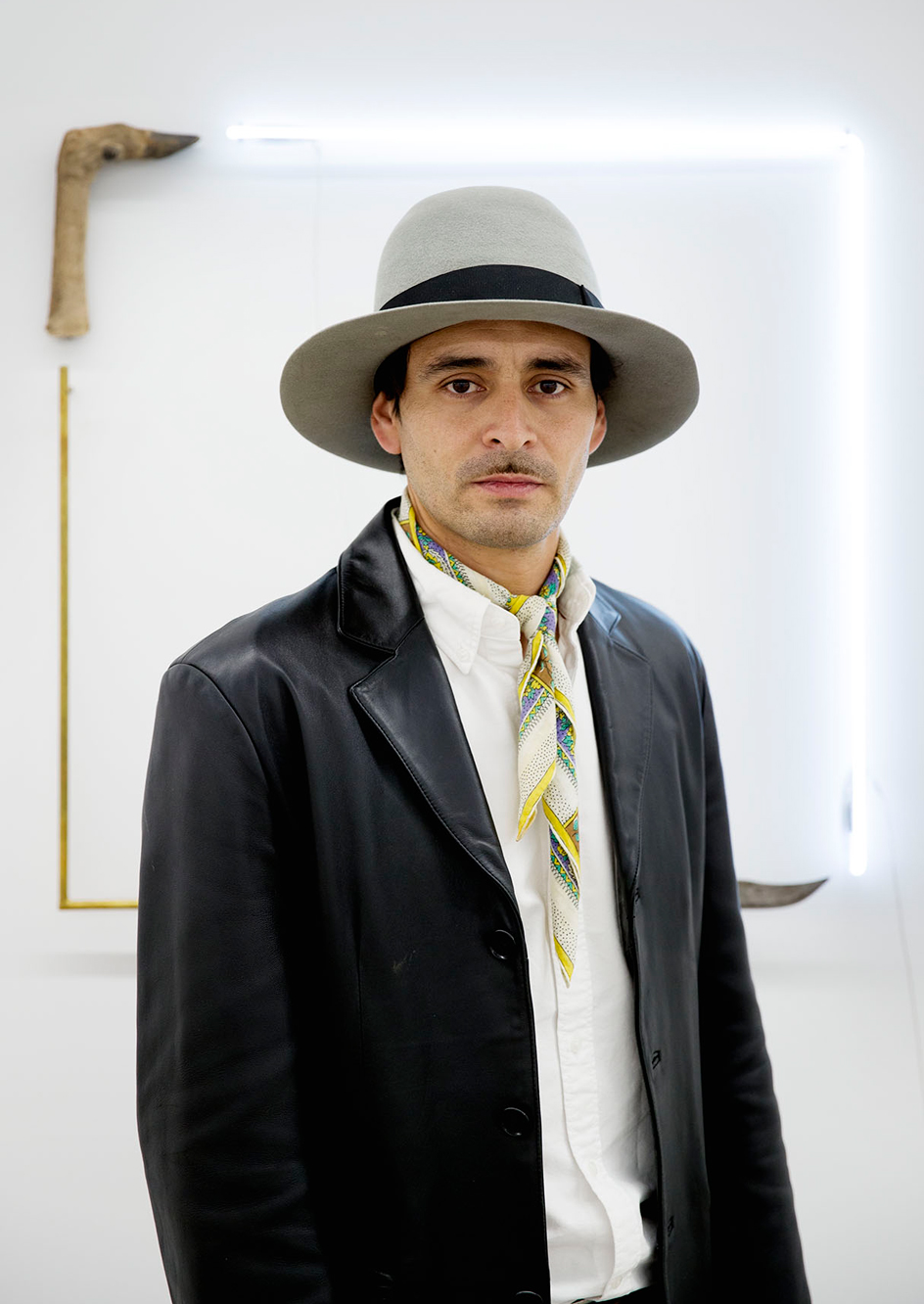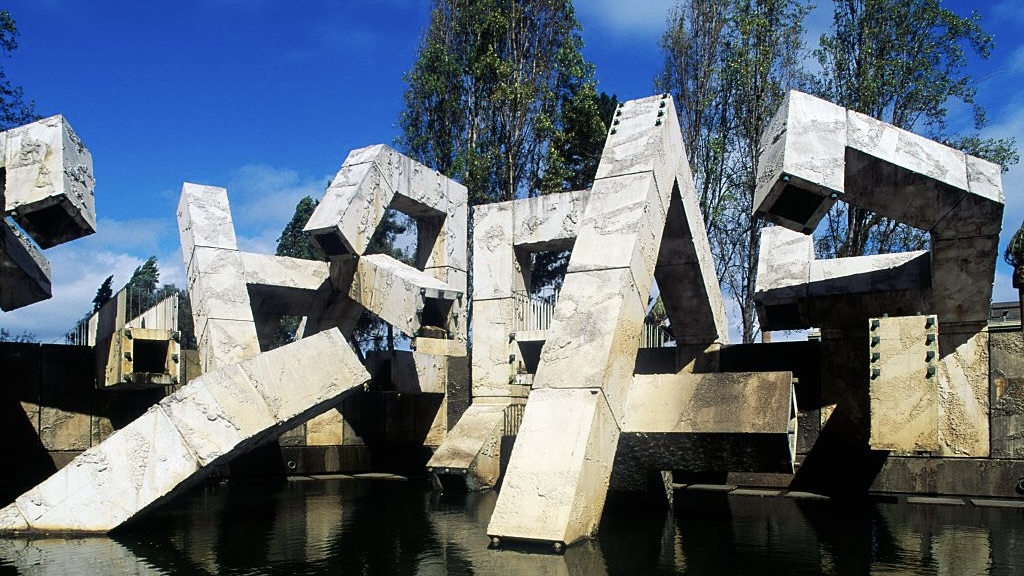At home with artist Gabriel Rico
Even in a period of social distancing, the art world continues to turn. In our ongoing series, we go home, from home, with artists finding inspiration in isolation. Reached during his temporary seclusion among the Mexican mountains, Gabriel Rico reveals how his poetic assemblages of found objects draw on culture, philosophy and the natural order of things

A deer head cradling various sports balls between its antlers, two real feathers hidden in plain sight among a wall of brass facsimiles, golden honey trickling from a suspended ceramic beehive onto a human skull: these are all motifs that Gabriel Rico has used to captivating effect. His combinations of found objects, taxidermy, branches and neon may at first appear bewildering, but on deeper inspection, can enlighten us to the evolving relationship between humans and the natural environment. We catch up from afar with the Mexican conceptual artist ahead of a solo show at Perrotin Paris this summer and a more imminent takeover of the gallery’s Instagram.
Wallpaper*: Where are you as we speak?
Gabriel Rico: I am in a cabin in the middle of the Sierra del Tigre in Jalisco. I decided to come here to collect objects (branches and stones), take advantage of the quarantine, and be alone in the company of my wife. We are in a natural area similar to a coniferous forest. The temperature is perfect, not as strong as the heat in the city. At sunrise and sunset, the sound of birds is loud but pleasant, and golden light appears at around 7pm.

Gabriel Rico in front of his 2016 work Venado, comprising a brass rod, neon strip, knife, old coins and a deer hoof. Courtesy of Perrotin
W*: How has your education as an architect has informed your work as an artist?
GR: During my architecture studies I realised that the construction of a building requires the mixing of many materials to provide structural coherence and suggest a form to the construction. This is the same principle that guides the selection of materials I use to develop my works.
W*: You are known for collecting and configuring found objects for your sculptures and murals. What draws you to these objects, and what is your process of putting them together into an artwork?
GR: My relationship with the objects, and the meaning they acquire when I change their context and utilise them in a new situation, outside their logic of use. I am also inspired by scientific principles and some philosophical analogies and normally use this like a base to start new compositions or pieces.
W*: What are some unusual items in your collection that you are hoping to include in future artworks?
GR: The collection that I have is a mixture of natural objects (rocks, shells, branches, and animal remains such as horns or skins), and objects that are directly related to the Anthropocene, and the ideology of the period in which I live. These objects range from porcelain flowers and ceramic plates to CDs, old cell phones, glass bottles, plastic fruits, and balls from different sports. When I decide to keep one of these objects, it is not clear when I will use it and even less so, in what type of work. I have kept objects for several years until I finally find the perfect piece to use as a complement.

Inside the artist’s studio in Guadalajara, Mexico.
W*: What is the role of humour in your practice?
GR: I do not think consciously that humour is part of my work. And it’s necessary to define what kind of humour is seen in my work – some have told me that it is ironic, others sarcastic. I consider it as a part of my personality that is reflected in my work. The physicist Leon Lederman said that humour has a value on the social scale very similar to that of love or sadness. He believed that the character of humour (when it is genial) is universal since it does not depend on language to understand itself.
RELATED STORY

W*: What has been the highlight of your career so far?
GR: The residencies I had in countries like Colombia, South Korea and Belgium opened my eyes to the artistic practices that were happening internationally at the beginning of the past decade, and I was able to see the real level of my art. Of course, having exhibited at the Venice Biennale and in museums such as the Aspen Art Museum in the US, in addition to exhibiting at Galerie Perrotin, brings me great satisfaction, because I realised what I was thinking and doing had value for various people involved in contemporary art – collectors, curators, gallery owners, etc.
Receive our daily digest of inspiration, escapism and design stories from around the world direct to your inbox.

Gabriel Rico, To be Preserved without scandal and corruption, 2020. Volcanic stone, rope, taxidermy axis deer, fibreglass column.
W*: What’s the most interesting thing you’ve read or listened to in the last few weeks?
GR: The discovery of a new class of subatomic particles called Pc (4312)+, proposed by Tomasz Skwarnicki, a professor of physics at the Faculty of Arts and Sciences at Syracuse University.
W*: Your next solo show, at Galerie Perrotin Paris this summer, is titled ‘Nature loves to hide’. What ideas are you looking to articulate through this show?
GR: ‘Nature Loves to Hide’ is a quote from the Greek philosopher Heraclitus, which I chose as the title for its simplicity and elegance. It references a fact that continually stuns us when trying to find quantitative meaning in the natural world: nature exists for itself and not for our needs.
This new body of work suggests a journey to a certain time. I carefully select the natural elements in each piece — when making these decisions and selecting each element, I act as though I have deciphered the mysterious relationship between man-made and natural objects.

Gabriel Rico, III, from the series Unity & Uniformity (La Mitla de hérétiques), 2020. Feathers, brass.
W*: Are there elements of the show that have taken on new meaning in light of recent global events?
GR: We are seeing how nature is regaining ground within cities - wild felines walking on the streets of cities in Southeast Asia, bears walking in downtown Chicago, the crystal clear waters of Venice. I try to make my work reflect on the possibility of the extinction of the human race, the possible ruins of civilisation, and how nature would react to a situation like this. The interesting thing for me at this moment of crisis is to be able to have a glimpse into a small part of what could happen. In this sense, most of my work is related, in one way or another, with what is currently happening.
INFORMATION
Gabriel Rico will be in conversation with Patrick Charpenel, executive director of New York’s El Museo del Barrio, on Instagram Live @galerieperrotin on 25 April, at 12PM New York / 6PM Paris. The conversation will be in Spanish.
Rico’s Instagram takeover of @galerieperrotin will take place on 26 April, at 10AM New York/ 4PM Paris.
His solo show, ‘Nature loves to hide’, will open this summer at Galerie Perrotin, 76 Rue Turenne, Paris 3e, perrotin.com
TF Chan is a former editor of Wallpaper* (2020-23), where he was responsible for the monthly print magazine, planning, commissioning, editing and writing long-lead content across all pillars. He also played a leading role in multi-channel editorial franchises, such as Wallpaper’s annual Design Awards, Guest Editor takeovers and Next Generation series. He aims to create world-class, visually-driven content while championing diversity, international representation and social impact. TF joined Wallpaper* as an intern in January 2013, and served as its commissioning editor from 2017-20, winning a 30 under 30 New Talent Award from the Professional Publishers’ Association. Born and raised in Hong Kong, he holds an undergraduate degree in history from Princeton University.
-
 Alexander Wessely turns the Nobel Prize ceremony into a live artwork
Alexander Wessely turns the Nobel Prize ceremony into a live artworkFor the first time, the Nobel Prize banquet has been reimagined as a live artwork. Swedish-Greek artist and scenographer Alexander Wessely speaks to Wallpaper* about creating a three-act meditation on light inside Stockholm City Hall
-
 At $31.4 million, this Lalanne hippo just smashed another world auction record at Sotheby’s
At $31.4 million, this Lalanne hippo just smashed another world auction record at Sotheby’sThe jaw-dropping price marked the highest-ever for a work by François-Xavier Lalanne – and for a work of design generally
-
 NYC’s first alcohol-free members’ club is full of spirit
NYC’s first alcohol-free members’ club is full of spiritThe Maze NYC is a design-led social hub in Flatiron, redefining how the city gathers with an alcohol-free, community-driven ethos
-
 Out of office: the Wallpaper* editors’ picks of the week
Out of office: the Wallpaper* editors’ picks of the weekAnother week, another sweep of culture in the capital and beyond for the Wallpaper* team. This time: hidden book fairs, standout theatre, and a taste of the Mediterranean – from a Spanish showcase to seafood in the Portuguese archipelago
-
 Out of office: the Wallpaper* editors’ picks of the week
Out of office: the Wallpaper* editors’ picks of the weekSummer holidays are here, with Wallpaper* editors jetting off to some exceptional destinations, including highly recommended Mérida in Mexico. Then it’s back to work, or, for one editor, back to school…
-
 Rolf Sachs’ largest exhibition to date, ‘Be-rühren’, is a playful study of touch
Rolf Sachs’ largest exhibition to date, ‘Be-rühren’, is a playful study of touchA collection of over 150 of Rolf Sachs’ works speaks to his preoccupation with transforming everyday objects to create art that is sensory – both emotionally and physically
-
 Architect Erin Besler is reframing the American tradition of barn raising
Architect Erin Besler is reframing the American tradition of barn raisingAt Art Omi sculpture and architecture park, NY, Besler turns barn raising into an inclusive project that challenges conventional notions of architecture
-
 What is recycling good for, asks Mika Rottenberg at Hauser & Wirth Menorca
What is recycling good for, asks Mika Rottenberg at Hauser & Wirth MenorcaUS-based artist Mika Rottenberg rethinks the possibilities of rubbish in a colourful exhibition, spanning films, drawings and eerily anthropomorphic lamps
-
 San Francisco’s controversial monument, the Vaillancourt Fountain, could be facing demolition
San Francisco’s controversial monument, the Vaillancourt Fountain, could be facing demolitionThe brutalist fountain is conspicuously absent from renders showing a redeveloped Embarcadero Plaza and people are unhappy about it, including the structure’s 95-year-old designer
-
 See the fruits of Niki de Saint Phalle and Jean Tinguely's creative and romantic union at Hauser & Wirth Somerset
See the fruits of Niki de Saint Phalle and Jean Tinguely's creative and romantic union at Hauser & Wirth SomersetAn intimate exhibition at Hauser & Wirth Somerset explores three decades of a creative partnership
-
 Technology, art and sculptures of fog: LUMA Arles kicks off the 2025/26 season
Technology, art and sculptures of fog: LUMA Arles kicks off the 2025/26 seasonThree different exhibitions at LUMA Arles, in France, delve into history in a celebration of all mediums; Amy Serafin went to explore